Jamila had gone out. The light demands of the new house allowed her endless periods of leisure, something that would have been inconceivable in her days packed with duties at the boardinghouse. Seeking to make up for lost time, the girl was going out constantly, using the excuse of having to do some little errand: “Siñorita want Jamila go buy sunflower seeds, yes?” Before I’d even answered she’d be trotting down the stairs in search of sunflower seeds, or bread, or fruit, or simply fresh air and freedom. I tore the pages out of the magazine and stuck them in my purse, then decided that I would go to La Luneta myself.
When I arrived I didn’t find the Matutera. There was no one home but the new servant girl toiling away in the kitchen, and the schoolmaster sitting beside the window, afflicted with a bad cold. He greeted me warmly.
“Well, well, how nicely life seems to be treating us now that we’ve changed our den,” he said, an ironic comment on my new appearance.
I barely paid attention to his remark, having other urgent matters to deal with.
“You don’t happen to know where I might find Candelaria, Don Anselmo?”
“Not in the slightest, child; you know she’s always here and there, flitting about like a lizard’s tail.”
I twisted my fingers nervously. I needed to find her, I needed a solution. The schoolmaster sensed my unease.
“Something up with you, girl?”
In desperation I turned to him for help.
“You aren’t by any chance good at drawing, are you?”
“Me? Absolutely not. Anything harder than an equilateral triangle and I’m lost.”
I didn’t have the faintest idea what that was, but all that mattered was that my old boardinghouse ally couldn’t help me. I went back to twisting my fingers and leaned out onto the balcony to see if I could see Candelaria returning. I looked at the street filled with people, tapped nervously on the railing. Then I heard Don Anselmo’s voice behind me.
“Why don’t you tell me what you’re after and we’ll see if I can help?”
I turned around.
“I need someone who draws well to copy some designs from a magazine.”
“Go to Bertuchi’s academy.”
“Whose?”
“Bertuchi, the painter.” The expression on my face gave away my ignorance. “Honestly, girl, you’ve been in Tetouan for three months and you still don’t know who Master Bertuchi is? Mariano Bertuchi, the greatest painter in Morocco?”
I didn’t know who this Bertuchi was, nor was I in the least bit interested. All I wanted was an urgent solution to my problem.
“And he’ll be able to draw me what I need?” I asked anxiously.
Don Anselmo gave a laugh, followed by a fierce coughing attack. The three packs of Toledo cigarettes a day were costing him dearly.
“The things you think of, Sirita, my child! How is Bertuchi going to draw clothing designs for you? Don Mariano is an artist, a man completely immersed in his painting, in making this country’s traditional arts survive and disseminating the image of Morocco beyond its borders—he’s not a portrait artist working on a commission! It’s just that in his school you’ll be able to find a number of people who’ll be able to give you a hand: young painters without a lot to do, girls and boys attending painting classes.”
“And where is this school?” I asked, putting on my hat and quickly grabbing my bag.
“Next to the Puerta de la Reina.”
The confusion on my face must have moved him again, because—after another rough laugh and one more bout of coughing—he got up from his seat with some effort and added, “Come on, then, let’s go; I’ll come with you.”
We left La Luneta and entered the mellah, the Jewish quarter. As we walked down its tidy, narrow streets, I silently remembered my aimless wanderings on the night with the guns. Everything seemed different by daylight, however, with the small businesses and the currency exchanges open. We then went into the Moorish alleys of the medina, with its labyrinthine web in which I still found it hard to get my bearings. Despite the height of my heels and the tubular narrowness of my skirt, I tried to walk at a good trot over the cobblestones. Don Anselmo was prevented from keeping pace, due to his age and his cough, not to mention his incessant chatter about the coloring and the luminosity of Bertuchi’s paintings; about his oils, his watercolors, and pen-and-ink drawings; about what the painter had done to promote the school of indigenous arts and the fine arts preparatory school.
“Have you sent any letters back to Spain from Tetouan?” he asked. “Well, almost all the stamps of the Protectorate are based on Bertuchi’s drawings. Pictures of Alhucemas, Alcazarquivir, Xauen, Larache, Tetouan. Landscapes, people, scenes of everyday life: all come from his brush.”
We walked on, he talking, I trying to quicken the pace as I listened.
“And the posters and placards to promote tourism, haven’t you seen those either? I don’t imagine that in these ill-fated times anyone is planning to come out to Morocco for pleasure, but for years it’s been Bertuchi’s art that has been responsible for spreading the word about this country’s bounties.”
I knew which posters he was referring to. They were stuck up in a lot of places; I used to see them every day. Prints of Tetouan, Ketama, Arzila, and other spots of interest. And under them, the line “Spanish Protectorate in Morocco.” It would not be long before they changed the name.
We reached our destination after a good walk on which we found ourselves passing men and souqs, goats and children, jackets and djellabas, voices haggling, well-swathed women, dogs and puddles, chickens, the smells of coriander and mint, of baking bread and olive dressings; in short, a torrent of life. The school was on the edge of the city, in a building that belonged to an old fort that loomed over the city wall. There was a certain amount of bustle in its vicinity, with young people coming in and out, some of them carrying large folders under their arms, some of them alone, and some chatting in groups.
“Here we are. I’ll leave you and take advantage of this outing to get a little glass of wine with some friends who live in La Suica. I haven’t been getting out much lately and I have to make the most of it every time I do.”
“And how do I get back?” I asked, doubtful. I hadn’t paid the slightest attention to the twists and turns of our route, thinking the schoolmaster would be making the return journey with me.
“Don’t worry about that, any of these young men would be delighted to help you. Good luck with the drawings—you’ll tell me later how you got on.”
I thanked him for coming with me, went up the steps and into the enclosure. I noticed several stares suddenly lighting on me; in those days they can’t have been used to the presence of a woman like me in that school. I went halfway into the entrance hall and stopped, uneasy, lost, not knowing what to do or whom to ask for. Before I had time to take my next step, I heard a voice behind me.
“Well, well—my pretty neighbor.”
I turned, with no idea who could possibly have uttered those words, and saw the young man who lived opposite me. There he was, this time on his own. Many pounds heavier and with a lot less hair than someone who hadn’t yet reached thirty should have. He didn’t even let me speak.
“You seem a little adrift. Can I help?”
It was the first time he had ever addressed me. Even though we’d crossed paths several times since my arrival, I’d always seen him accompanied by his mother. On those occasions neither of us had murmured more than a polite good afternoon. I was also familiar with a less pleasant aspect to their voices: the one I heard from my house almost every night, when mother and son became embroiled in the most heated, stormy discussions. I decided to be candid with him: I hadn’t prepared any evasions.
Читать дальше












